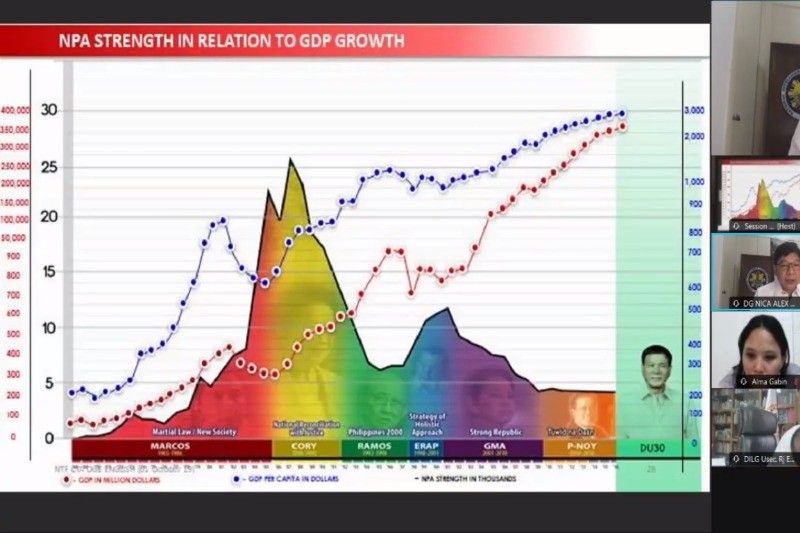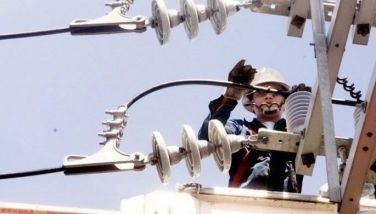Fact check: Lower number of communist rebels means faster economic growth?

MANILA, Philippines — The short answer is no.
At a Senate hearing on Tuesday, the country’s top intelligence official wrongly claimed that the strength of New People’s Army (NPA) — the armed-wing of the Communist Party of the Philippines (CPP) — is directly correlated to the country’s economic performance.
To prove his point, Alex Paul Monteagudo, director-general of National Intelligence Coordinating Agency (NICA), presented to senators a graph from his post-graduate dissertation that tries to establish a relationship between the size of the NPA's force and gross domestic product (GDP) growth and GDP per capita, a measure of how economic wealth is distributed among the population.
“If you will notice, Mr. Chairman, the strength of the CPP peaked in 1987 and then it went down. Why did it go down? It was after EDSA and then it went all the way down to (former President Fidel V. Ramos') time because the CPP was destroying itself. This was the time when there was an internal cleansing within their ranks,” Monteagudo told senators.

“What is its effect in our GDP and economy? When there is a decline in the strength of CPP, there are better business and investment opportunities. The GDP goes up when CPP (strength) goes down,” he added, partly in Filipino.
Nobody at the Senate hearing pierced through the multicolored chart, but a direct correlation between the number of communist guerrillas, defined as CPP’s “strength,” and GDP is murky at best. It was unclear what the reasoning behind the chart is, but several studies have pointed to the absence of conflict as a prime driver of economic growth. That however is not hinged on lessening rebel numbers, but rather on successful peace talks.
Hence, the closest assessment there is to this is how several observers have repeatedly cited the need for peace in Mindanao to reap the region’s economic benefits.
Toward this end, several administrations, including that of President Rodrigo Duterte early in his term, have tried to achieve peace through negotiations. But Monteagudo also claimed peace talks are ineffective tools to fix the insurgency problem.
“It’s true that FVR (Ramos) implemented a lot of programs but did it eliminate the problem? The problem was the government was always engaged in peace talks. All administrations were engaged in peace talks,” he said.
“If it’s all peace talks, the security sector at intelligence community cannot say anything. They cannot expose (CPP) because they will be accused of spoilers of peace,” he added.
Ineffective peace talks?
But while indeed insurgency remains a challenge to long-term prosperity to date, Monteagudo’s claims against the effectiveness of peace talks are to say the least, problematic. In 2018, the National Economic and Development Authority assessed how the new Bangsamoro Organic Law would impact Mindanao, and it has one solid conclusion: the region’s growth potentials are only bound to be realized.
The BOL, however, was only a product of 3 decades of peace talks between the Moro Islamic Liberation Front (MILF), a group that advocated for a better autonomous system in Mindanao. In fact, when Duterte took office in June 2016, he crafted BOL based on the components of a preceding proposal under the previous administration, the Bangsamoro Basic Law, which got stalled because of some contentious provisions.
Yet even in the run-up to the Bangsamoro’s establishment, NEDA itself already recognized the benefits of early peace talks to economic activity. “Private sector investments in recent years have also registered marked improvements, following the advances in the peace negotiations,” NEDA said in a 2018 report.
For instance, in 2014, NEDA said investments in Mindanao doubled to P3.3 billion from a year ago. More people also entered the labor force that reached 70% that year from just 55.5% in 2011.
“In Mindanao, peace and development will hinge on the success of a political solution that addresses the causes of violence— injustice, weak governance, land dispossession, discrimination and sociocultural marginalization,” the World Bank said in a June 2017 report.
The same impact can be gleaned from the 1996 Peace Accord signed by the Ramos administration with another group, the Moro National Liberation Front. While the BOL was the product of the shortcomings of the original pact, the latter did address bigger challenges at the time.
Chart problems
The long way to peace, of course, can be winding, and as a result previous governments have stumbled in the process. This is the same idea that governs peace negotiations with CPP-NPA, one which Duterte, who hails from Mindanao, had ultimately abandoned in 2018 after flip-flopping numerous times during his presidency.
Instead, he labeled them terrorist— the US had long labeled CPP-NPA as one— and declared war against them. So far however, there is little evidence of success in this government strategy.
At face value however, the chart presented by the intel chief at the Senate hearing was also problematic. The scales used in the "y-axis" of chart used GDP and per capita values in million dollars, which are not properly labeled whether based on current or the most commonly used constant 2018 prices that control for inflation.
The chart also did not include data for the Duterte administration. Monteagudo nonetheless said that even without figures under the present government in the chart, "we know the economy enjoyed a continued rise" under Duterte "except after COVID-19."
- Latest
- Trending






























